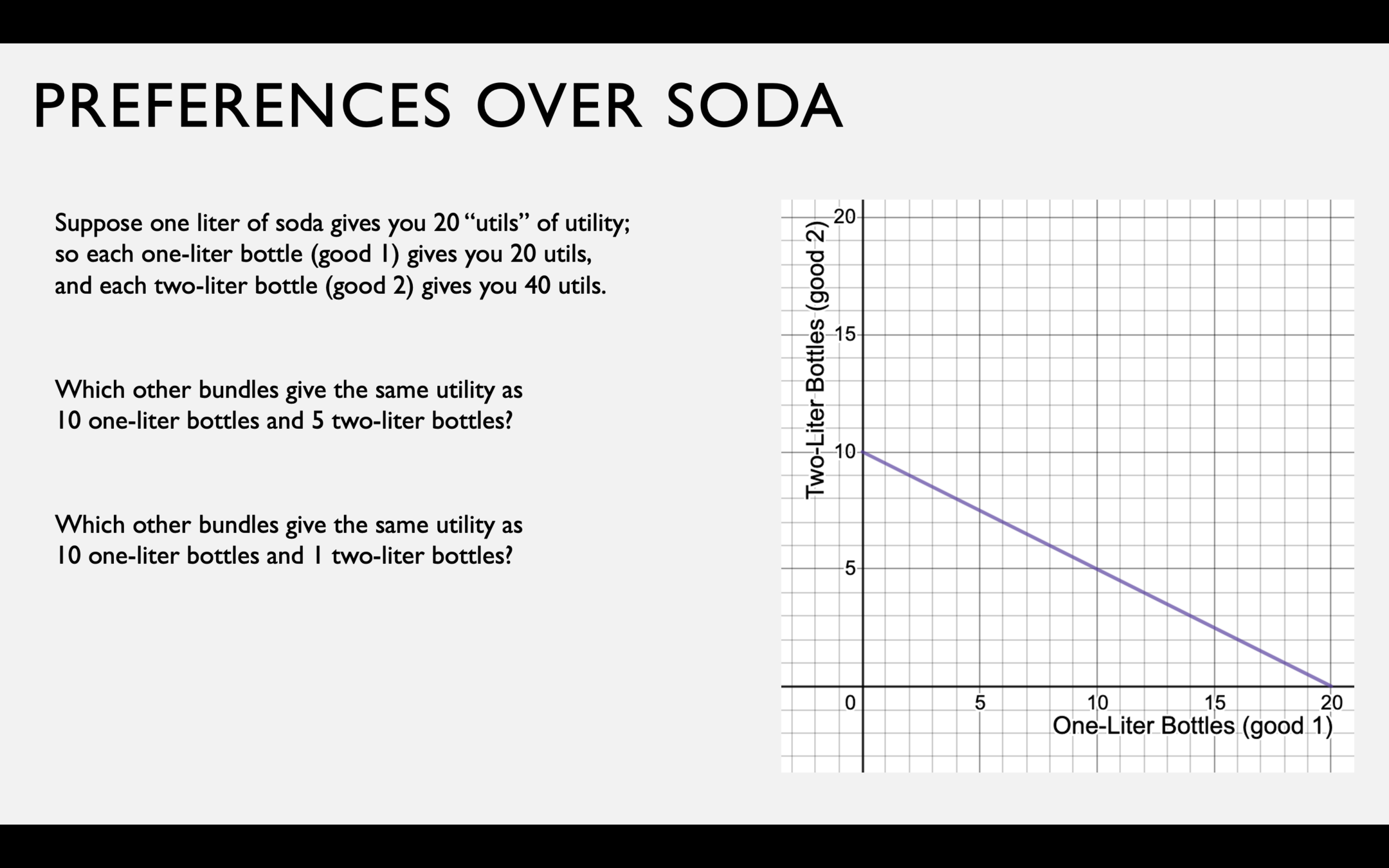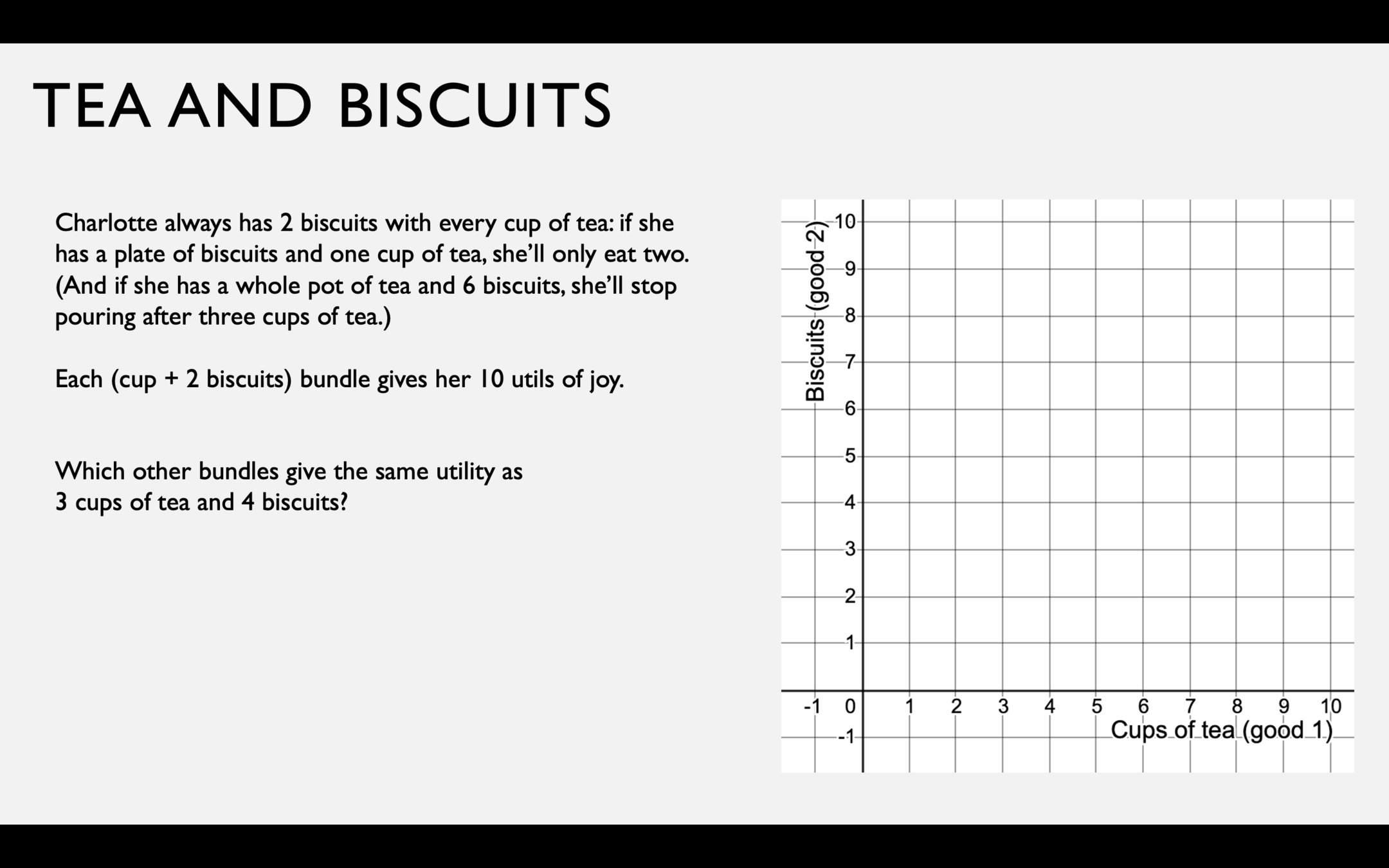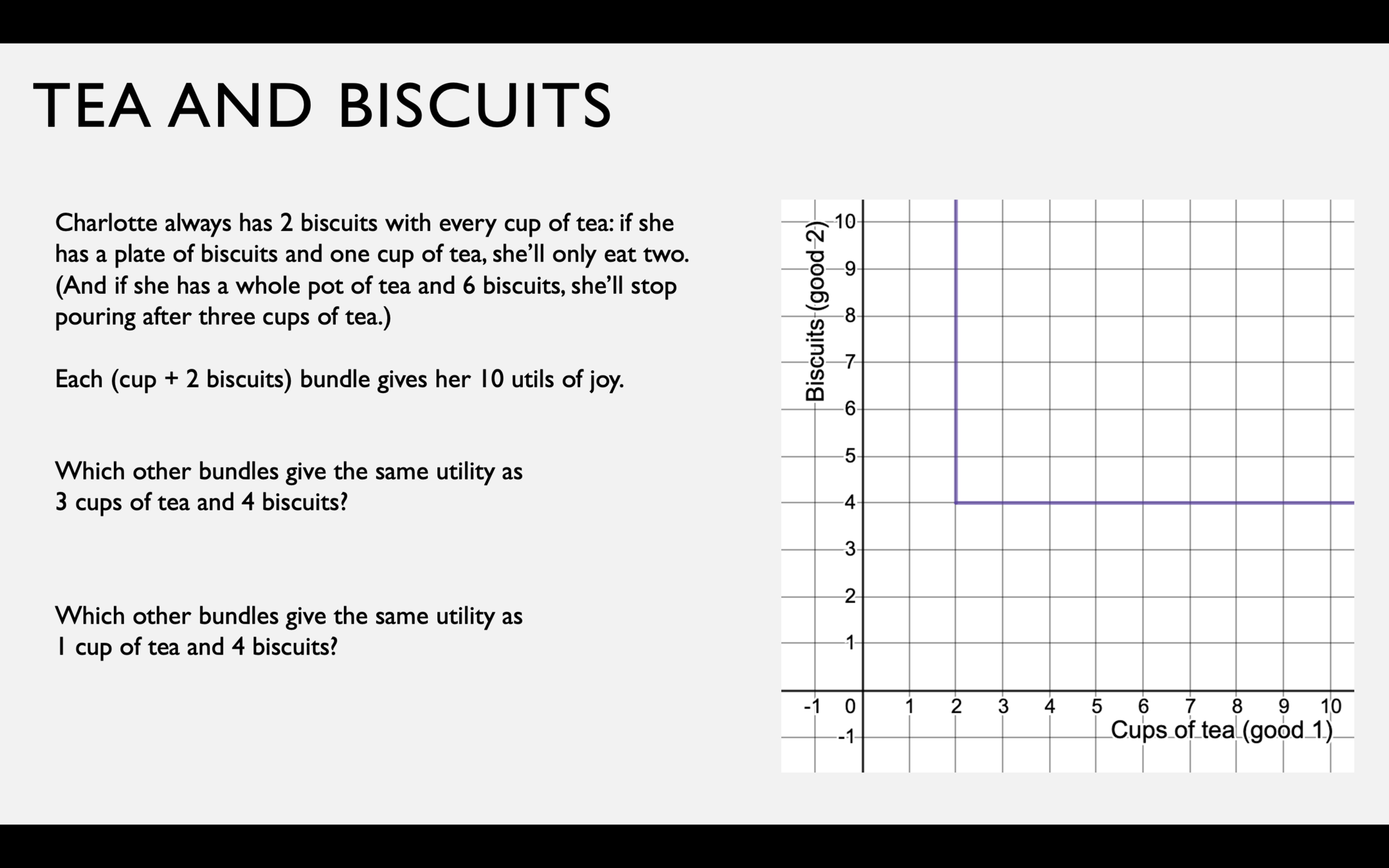Preferences and Utility
Christopher Makler
Stanford University Department of Economics
Econ 50: Lecture 3
Today's Agenda
Part 1: Modeling Preferences with Utility Functions
Part 2: Some "canonical" utility functions
Preferences: Definition and Axioms
Quantifying Happiness
Utility Functions
Indifference Curves and the MRS
Perfect Substitutes
Perfect Complements
Cobb-Douglas
Quasilinear
Review: Preferences
Preferences: Ordinal Ranking of Options
Given a choice between option A and option B, an agent might have different preferences:
The agent strictly prefers A to B.
The agent strictly disprefers A to B.
The agent weakly prefers A to B.
The agent weakly disprefers A to B.
The agent is indifferent between A and B.
Preference Axioms
Complete
Transitive
Any two options can be compared.
If \(A\) is preferred to \(B\), and \(B\) is preferred to \(C\),
then \(A\) is preferred to \(C\).
Together, these assumptions mean that we can rank
all possible choices in a coherent way.
Visually: the MRS is the magnitude of the slope
of an indifference curve
Quantifying Happiness
How do I love thee? Let me count the ways.
I love thee to the depth and breadth and height
My soul can reach, when feeling out of sight
For the ends of Being and ideal Grace.
I love thee to the level of everyday’s
Most quiet need, by sun and candlelight.
I love thee freely, as men strive for Right;
I love thee purely, as they turn from Praise.
I love thee with the passion put to use
In my old griefs, and with my childhood’s faith.
I love thee with a love I seemed to lose
With my lost saints,—I love thee with the breath,
Smiles, tears, of all my life!—and, if God choose,
I shall but love thee better after death.
Elizabeth Barrett Browning
Sonnets from the Portugese 43
18th/19th Centuries: Utilitarianism
the greatest happiness of the greatest number
is the foundation of morals and legislation.

Jeremy Bentham
the utilitarian standard...
is not the agent's own greatest happiness,
but the greatest amount of happiness, altogether.

John Stuart Mill
Introduction to the Principles of Morals and Legislation (1789)
Utilitarianism (1861)
Utility Functions
How do we model preferences mathematically?
Multivariable Function
Utility Function
Good 1
Good 2
Utility
Utility Functions: Cardinal Ranking of Options
"A is strictly preferred to B"
Words
Preferences
Utility
"A is weakly preferred to B"
"A is indifferent to B"
"A is weakly dispreferred to B"
"A is strictly dispreferred to B"
Suppose the "utility function"
assigns a real number (in "utils")
to every possible consumption bundle
We get completeness because any two numbers can be compared,
and we get transitivity because that's a property of the operator ">"
Indifference Curves as Level Sets
An indifference curve is a set of all bundles between which a consumer is indifferent.
If a consumer is indifferent between two bundles (A ~ B), then \(u(a_1,a_2) = u(b_1,b_2)\)
Therefore, an indifference curve is a set of all consumption bundles which are assigned the same number of "utils" by the function \(u(x_1,x_2)\)
Likewise, set of bundles preferred to some bundle A is the a set of all consumption bundles which are assigned a greater number of "utils" by \(u(x_1,x_2)\)
Do we have to take the
number of "utils" seriously?
Example: draw the indifference curve for \(u(x_1,x_2) = \sqrt{x_1,x_2}\) passing through (10,40).
Step 1: Evaluate \(u(x_1,x_2)\) at the point
Step 2: Set \(u(x_1,x_2)\) equal to that value.
Step 4: Plug in various values of \(x_1\) and plot!
\(u(10,40) = \sqrt{10 \times 40} = 20\)
\(\sqrt{x_1x_2} = 20\)
\(x_2 = \frac{400}{x_1}\)
How to Draw an Indifference Curve through a Point
Step 3: Solve for \(x_2\).
How would this have been different if the utility function were \(u(x_1,x_2) = 2\sqrt{x_1x_2}\)?
\(u(10, 40) = 2\sqrt{10 \times 40} = 40\)
\(2\sqrt{x_1x_2} = 40\)
\(x_2 = \frac{400}{x_1}\)
All we want to use utility functions for
is to describe preference orderings.
It doesn't matter that “utils" are nonsense.
As long as the utility function generates the correct indifference map,
it doesn't matter what the level of utility at each indifference curve is.
MRS and Marginal Utility
Marginal Utility
Econ 1: "The additional utility you get from consuming another unit of the good"
Now that we know calculus, it's much easier:
Monotonic Preferences: “More is Better"
Marginal Rate of Substitution
From last time: "The amount of good 2 you would give up in order to get another unit of good 1 and be no better or worse off"
How much utility do you lose when you give up \(dx_2\) units of good 2?
How much utility do you gain when you get \(dx_1\) units of good 1?
If you gain the same amount of utility from good 1 as you lost from good 2, can you express the MRS in terms of \(dx_1\) and \(dx_2\)?
pollev.com/chrismakler


A
B
Transforming Utility Functions
Applying a positive monotonic transformation to a utility function doesn't affect
the way it ranks bundles.
Example: \(\hat u(x_1,x_2) = 2u(x_1,x_2)\)
Transformations and the MRS
Applying a positive monotonic transformation to a utility function doesn't affect
its MRS at any bundle (and therefore generates the same indifference map).
Example: \(\hat u(x_1,x_2) = 2u(x_1,x_2)\)
Transformations and the MRS
Applying a positive monotonic transformation to a utility function doesn't affect
its MRS at any bundle (and therefore generates the same indifference map).
Example: \(\hat u(x_1,x_2) = \ln(u(x_1,x_2))\)
pollev.com/chrismakler

Normalizing Utility Functions
One reason to transform a utility function is to normalize it.
This allows us to describe preferences using fewer parameters.
[ multiply by \({1 \over a + b}\) ]
[ let \(\alpha = {a \over a + b}\) ]
Examples of Utility Functions


pollev.com/chrismakler

Perfect Substitutes
Goods that can always be exchanged at a constant rate.
-
Red pencils and blue pencils, if you con't care about color
-
One-dollar bills and five-dollar bills
-
One-liter bottles of soda and two-liter bottles of soda


pollev.com/chrismakler

Perfect Complements
Goods that you like to consume
in a constant ratio.
Left shoes and right shoes
Sugar and tea
Cobb-Douglas
An easy mathematical form with interesting properties.
-
Used for two independent goods (neither complements nor substitutes) -- e.g., t-shirts vs hamburgers
-
Also called "constant shares" for reasons we'll see later.
Quasilinear
Generally used when Good 2 is
"dollars spent on other things."
-
Marginal utility of good 2 is constant
-
If good 2 is "dollars spent on other things," utility from good 1 is often given as if it were in dollars.
Concave
The opposite of convex: as you consume more of a good, you become more willing to give up others
-
MRS is increasing in \(x_1\) and/or decreasing in \(x_2\)
-
Indifference curves are bowed away from the origin.
Satiation Point
There is some ideal bundle; utility falls off as you move away from that bundle
-
Not monotonic
-
Realistic, but often the satiation point is far out of reach.
"Semi-Satiated"
One good has an ideal quantity; the other doesn't
-
Can be a combination of quasilinear and satiation point
-
Can generate the familiar linear demand curve